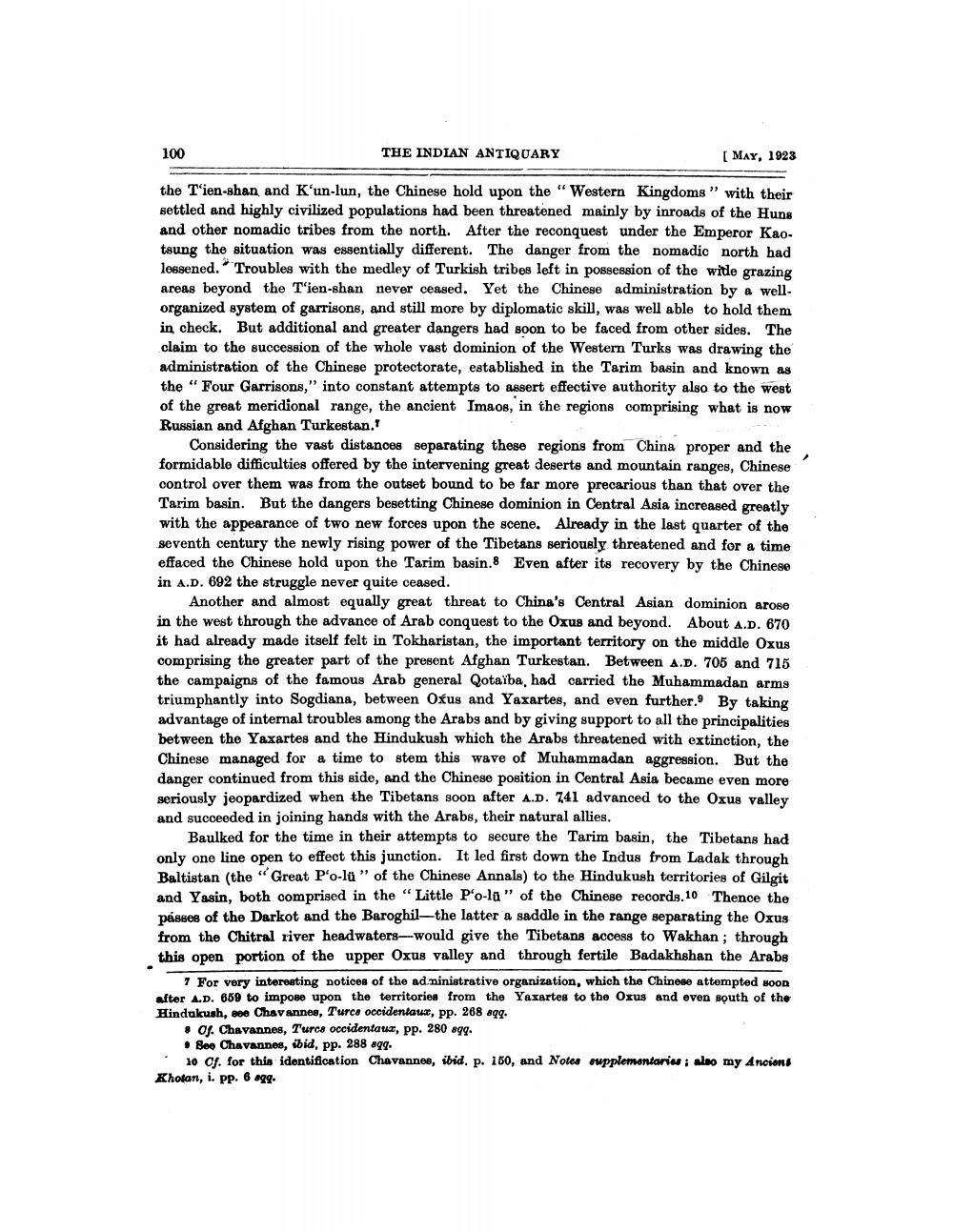________________
100
THE INDIAN ANTIQUARY
[ MAY, 1923
the Tien-shan and K'un-lun, the Chinese hold upon the Western Kingdoms” with their settled and highly civilized populations had been threatened mainly by inroads of the Huns and other nomadic tribes from the north. After the reconquest under the Emperor Kao. tsung the situation was essentially different. The danger from the nomadic north had lossened. Troubles with the medley of Turkish tribes left in possession of the witle grazing areas beyond the T'ien-shan never ceased. Yet the Chinese administration by a wellorganized system of garrisons, and still more by diplomatic skill, was well able to hold them in check. But additional and greater dangers had soon to be faced from other sides. The claim to the succession of the whole vast dominion of the Western Turks was drawing the administration of the Chinese protectorate, established in the Tarim basin and known as the "Four Garrisons," into constant attempts to assert effective authority also to the west of the great meridional range, the ancient Imaos, in the regions comprising what is now Russian and Afghan Turkestan."
Considering the vast distances separating these regions from China proper and the formidable difficulties offered by the intervening great deserts and mountain ranges, Chinese control over them was from the outset bound to be far more precarious than that over the Tarim basin. But the dangers besetting Chinese dominion in Central Asia increased greatly with the appearance of two new forces upon the scene. Already in the last quarter of the seventh century the newly rising power of the Tibetans seriously threatened and for a time effaced the Chinese hold upon the Tarim basin.8 Even after its recovery by the Chinese in A.D. 692 the struggle never quite oeased.
Another and almost equally great threat to China's Central Asian dominion arose in the west through the advance of Arab conquest to the Oxus and beyond. About A.D. 670 it had already made itself felt in Tokharistan, the important territory on the middle Oxus comprising the greater part of the present Afghan Turkestan. Between A.D. 705 and 715 the campaigns of the famous Arab general Qotaiba, had carried the Muhammadan arms triumphantly into Sogdiana, between Ośus and Yaxartes, and even further. By taking advantage of internal troubles among the Arabs and by giving support to all the principalities between the Yaxartes and the Hindukush which the Arabs threatened with extinction, the Chinese managed for a time to stem this wave of Muhammadan aggression. But the danger continued from this side, and the Chinese position in Central Asia became even more seriously jeopardized when the Tibetans soon after A.D. 741 advanced to the Oxus valley and succeeded in joining hands with the Arabs, their natural allies.
Baulked for the time in their attempts to secure the Tarim basin, the Tibetans had only one line open to effect this junction. It led first down the Indus from Ladak through Baltistan (the "Great Po-lü" of the Chinese Annals) to the Hindukush territories of Gilgit and Yasin, both comprised in the "Little Po-la ” of the Chinese records.10 Thence the pásses of the Darkot and the Baroghil—the latter a saddle in the range separating the Oxus from the Chitral river headwaters-would give the Tibetans access to Wakhan ; through this open portion of the upper Oxus valley and through fertile Badakhshan the Arabe
7 For very interesting notices of the adninistrative organization, which the Chinese attempted soon after A.D. 669 to impose upon the territories from the Yaxartes to the Oxus and even south of the Hindukush, eee Chavannes, Turca occidentaux, pp. 268 sqq.
# of. Chavannes, Turcs occidentaux, pp. 280 899.
• See Chavannes, ibid. pp. 288 899. . 10 Cf. for this identification Chavannes, ibid. p. 160, and Noten supplementaria i sloo my Ancions Khotan, i. pp. 6 a99.




